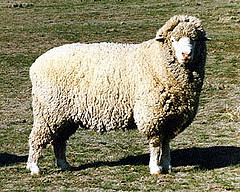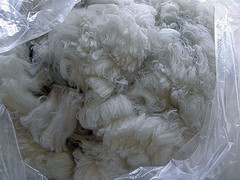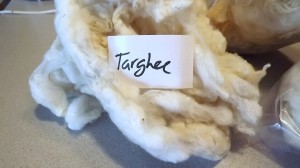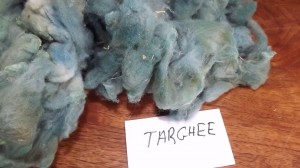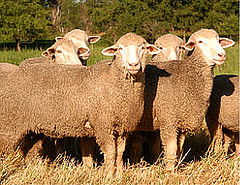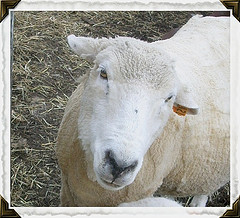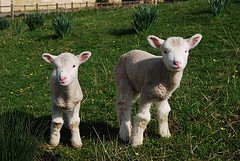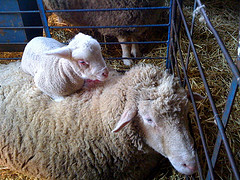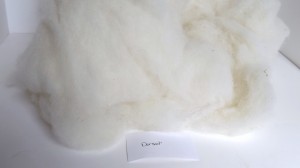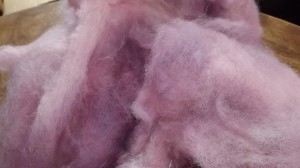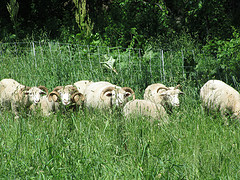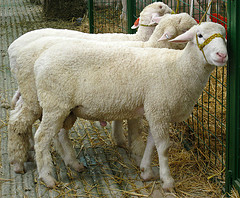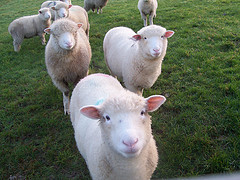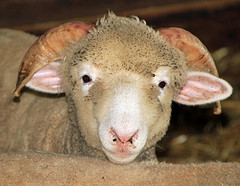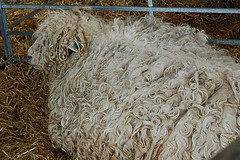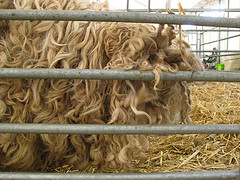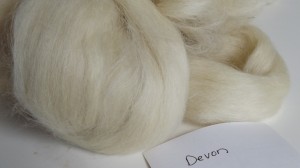Targhee Sheep average a good amount of wool. A ewe offers about 10-14 lbs of fleece per year. The staple is about 3-5 inches and the micron count is 21-25 making this a fine fleece.
The locks are super crimpy with lively springiness. It is a gorgeous white but a matt white I think it will take color beautifully. I believe this will make a lofty soft yarn when spun.
Here is my Targhee:
And after dyeing
Information from wikipedia and Oklahoma State University
P.S. If you would like to be notified whenever there is awesomely fibery update here click the RSS feed!
P.P.S. If you would like to know more about what’s going on around the farm and store upcoming specials sign up for our weekly newsletter!
Targhee Sheep are a mixed sheep created by blending Rambouillet, corriedale and Lincoln sheep. They were named after the Targhee National Forest which is near the U.S.Sheep Experiment Station where they were created. I kinda get the feeling that what was wanted was american dual purpose sheep. Development of the breed began in the early 1900’s the breed was recongized much later around the 1960’s.
Targhee’s are fairly popular in the midwest and are quite hardy. Rams weigh in aobut 200-300 pds and the ewe are slightly less around 125-200pds.
Mature body weight in the rams is 200 lb (90 kg) to 300 lb (135 kg) with the ewes w eighing slightly less at 125 lb (56 kg) to 200 lb (90 kg). This is definitely a larger sheep.
Targhee Sheep are as American as apple pie. The way I see it they are melting pot sheep created here just as america is a melting pot for people. It’s kind of fitting to be revealing this sheep this week.
P.S. If you would like to be notified whenever there is awesomely fibery update here click the RSS feed!
P.P.S. If you would like to know more about what’s going on around the farm and store upcoming specials sign up for our weekly newsletter!

I didn’t mention in the video that it’s Dwayne’s B-day today. Love you honey because I know you always check this out and read over my shoulder. lol
Links Mentioned:
Patterns Mentioned:
Lion Brand Summer Cal
Fibers:
Sherbert
P.S. If you would like to be notified whenever there is awesomely fibery update here click the RSS feed!
P.P.S. If you would like to know more about what’s going on around the farm and store upcoming specials sign up for our weekly newsletter!
I found my Polled dorset wool to be wonderfully soft with a springiness that was just wonderful. I had no problem keeping this fiber next to my skin for an extended amount of time(in fact I forgot it was there). I only found references to this breed having white fiber. Although the fleece and fiber sourcebook states” there are some colored dorsets.”
Fleeces average 5 to 9 pounds . The staple length ranges from 2.5 to 4 inches (6 to 10 cm) 2.5 inches (6 cm) to 4 inches (10 cm). The fiber diameter ranges 26 to 33 microns.
Here is my dorset wool:
I dyed some up as well it looks awesome!!!!
I used this dorset as part of my dyeing experiment I started last week with the devon fiber. You can see more about that here.
Hey! I will be adding more blog fibers to the etsy store you can check that out here!!!!!
P.S. If you would like to be notified whenever there is awesomely fibery update here click the RSS feed!
P.P.S. If you would like to know more about what’s going on around the farm and store upcoming specials sign up for our weekly newsletter!
The Dorset Horn sheep is one of the earliest recorded breeds of British Sheep with the first Flock Book being established in 1892. The Dorset Horn sheep was soon engineered to be polled amazingly enough this took place in both the U.S. and Australia. Both breeds still maintain the attributes of the original breed.
One of the biggest attributes that is well loved about the dorset horned and polled dorset, is the ability to breed at anytime of year which allows the breeder to plan lambing better. They are able to lamb 3 times in a 2 yr period.
An interesting mutation has happened in Oklahome in 1983. A ram was born with amazingly muscular buttocks. The mutation has since been named Callipyge (which is greek for beautiful butt). The gene can be passed from the ram to lambs.
The sheep on the left has the Callipyge gene. Picture by Bob Rost
Ewes weigh in at about 150-200 pds, Rams can weigh about 225 to 275 pds. Have a bright white fleece with no kemp or black fibers.
I found the research for this breed to be quite confusing as there are other breeds called Dorset that are not related to the Dorset Horn and Polled Dorset. To keep things simple I will be doing a post specifically for the Dorset Down breed. The reason for the same name is that both breeds are geographically from the same area of Dorset County in England.
P.S. If you would like to be notified whenever there is awesomely fibery update here click the RSS feed!
P.P.S. If you would like to know more about what’s going on around the farm and store upcoming specials sign up for our weekly newsletter!
All information has been provided by wikipedia, Dorset Horn and Poll Dorset Sheep Breeder’s Association , and The Fleece and Fiber Sourcebook by Deborah Robson and Carol Ekarius.

If you liked the new sound and text effects please let me know. I want to hear your comments. If you have questions about a certain part of processing fiber or about a certain fiber feel free to ask.
Links from the video:
Knitter’s Block Links:
http://store.cocoknits.com/products/knitter%E2%80%99s-block.html
http://halcyonyarn.com/products/equipment/70610200.html
Gaia Spinning Fiber
Morning Fog Spinning Fiber
Maine Woods Fiber Yarn and Fiber
On The Round
P.S. If you would like to be notified whenever there is awesomely fibery update here click the RSS feed!
P.P.S. If you would like to know more about what’s going on around the farm and store upcoming specials sign up for our weekly newsletter!
These sheep produce a heavy fleece it can range from 10-20 pds. The staple length is amazing at 8-12 inches. This fiber is considered to be a carpet fleece as it’s pretty coarse with micron counts of 30-46. However first fleeces can be incredibly soft. The locks are curly with a defined tip.
My Devon top feels a bit silky and slippery with some crispyness. There were definitely some prickles at the neck that seemed to subside after a second. However I was pleasantly suprised that it wasn’t bad enough to remove it right away. I think if it was spun worsted it could be silky and drapey against the neck.
Here is my Devon top:
I also dyed up the batch into two slightly different colors for an experiment I’ll explain on the FFF video this week.
Information from https://www.rbst.org.uk/sitemanager/uploads/attachments/83_gallery.pdf and The Fiber and Fleece Sourcebook by Deborah Robson and Carol Ekarius
P.S. If you would like to be notified whenever there is awesomely fibery update here click the RSS feed!
P.P.S. If you would like to know more about what’s going on around the farm and store upcoming specials sign up for our weekly newsletter!
As I was researching Devon sheep I found some interesting facts. There are in fact 2 kinds of Devon sheep the Devon Closewool and the Devon Longwool. The Devon Longwool was originally the Devon Longwool and the South Devon Longwool or Cornwall Longwools. Talk about confusion!
It seems that the South Devon Longwool , the Cornwall Longwools and the the Devon Longwool have become one breed. The registries were even combined. They are now the Devon and Cornwall Longwool Association. So for clarity I will refer to them as Devon and Cornwall Longwools.
Devon and Cornwall Longwools are considered to be primitive sheep as there hasn’t been any new bloodlines introduced for quite some time. They are considered a dual-purpose sheep. Both sexes are polled. Ewes weight from 165 pds to 170 pds. The rams weigh in 220-245 pds. I’m impressed these are big sheep!
This breed of sheep is quite hardy and does great with just grazing. They are a bit shorter in the body and more compact than other similar breeds. Devon and Cornwall Longwools are rarely seen out of their original area. As a result this breed is on the watchlist at level 3 for the rare breeds survival trust. Being on the watchlist at level 3 means that there are only about 500-900 known breeding females. You can check out this information and information about other at risk domesticated animals at www.rbst.org.uk.
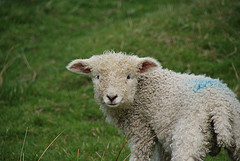
How cute is this little on with that curly fuzzy face???? Thanks to Bill Boaden of flickr for sharing.
Information from https://www.rbst.org.uk/sitemanager/uploads/attachments/83_gallery.pdf and The Fiber and Fleece Sourcebook by Deborah Robson and Carol Ekarius
P.S. If you would like to be notified whenever there is awesomely fibery update here click the RSS feed!
P.P.S. If you would like to know more about what’s going on around the farm and store upcoming specials sign up for our weekly newsletter!

